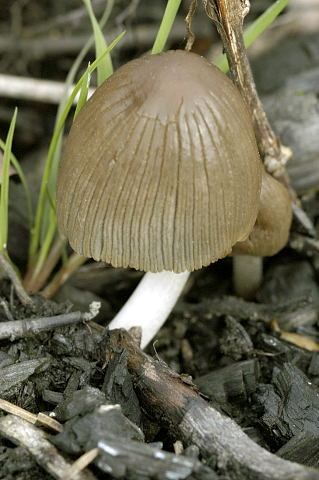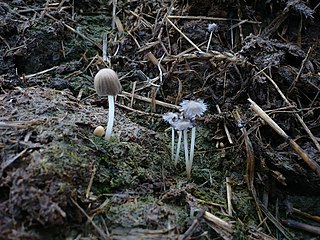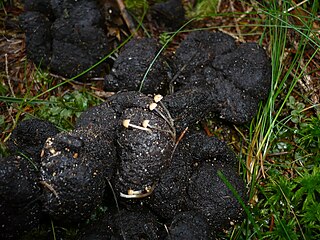
Coprinellus is a genus of mushroom-forming fungi in the family Psathyrellaceae. The genus was circumscribed by the Finnish mycologist Petter Adolf Karsten in 1879. Most Coprinellus species were transferred from the once large genus Coprinus. Molecular studies published in 2001 redistributed Coprinus species to Psathyrella, or the segregate genera Coprinopsis and Coprinellus.

Tulosesus amphithallus is a species of mushroom producing fungus in the family Psathyrellaceae.

Tulosesus angulatus is a species of mushroom producing fungus in the family Psathyrellaceae.

Tulosesus ephemerus is a species of mushroom producing fungus in the family Psathyrellaceae.

Coprinellus ellisii is a species of mushroom in the family Psathyrellaceae. Found in Europe, it was first described as Coprinus ellisii by Peter D. Orton in 1960, and later transferred to the genus Coprinellus in 2001. The specific epithet ellisii honours E.A. Ellis, who, according to Orton, was "the Norfolk naturalist and mycologist who collected this and who brought me many puzzling and apparently undescribed agarics."
Coprinellus dilectus is a species of mushroom in the family Psathyrellaceae. It was first described as Coprinus dilectus by mycologist Elias Magnus Fries in 1838, and later transferred to the genus Coprinellus in 2001.
Tulosesus callinus is a species of mushroom producing fungus in the family Psathyrellaceae.

Tulosesus bisporus is a species of mushroom producing fungus in the family Psathyrellaceae.
Tulosesus plagioporus is a species of mushroom producing fungus in the family Psathyrellaceae.

Tulosesus pellucidus is a species of mushroom producing fungus in the family Psathyrellaceae.
Tulosesus marculentus is a species of mushroom producing fungus in the family Psathyrellaceae.
Tulosesus hiascens is a species of mushroom producing fungus in the family Psathyrellaceae.
Tulosesus heterosetulosus is a species of mushroom producing fungus in the family Psathyrellaceae.
Tulosesus velatopruinatus is a species of mushroom producing fungus in the family Psathyrellaceae.
Tulosesus subpurpureus is a species of mushroom producing fungus in the family Psathyrellaceae.
Tulosesus subimpatiens is a species of mushroom producing fungus in the family Psathyrellaceae.
Tulosesus subdisseminatus is a species of mushroom producing fungus in the family Psathyrellaceae.
Tulosesus sclerocystidiosus is a species of mushroom producing fungus in the family Psathyrellaceae.
Tulosesus sassii is a species of mushroom producing fungus in the family Psathyrellaceae.

Tulosesus impatiens is a species of fungus in the family Psathyrellaceae. First described in 1821, it has been classified variously in the genera Psathyrella, Pseudocoprinus, Coprinarius, and Coprinus, before molecular phylogenetics reaffirmed it as a Coprinellus species in 2001. The fungus is found in North America and Europe, where the mushrooms grow on the ground in deciduous forests. The fruit bodies have buff caps that are up to 4 cm (1.6 in) in diameter, held by slender whitish stems that can be up to 10 cm (3.9 in) tall. Several other Coprinopsis species that resemble C. impatiens may be distinguished by differences in appearance, habit, or spore morphology.







